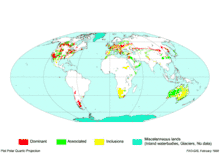Luvisol
Luvisols are a group of soils, comprising one of the 32 Reference Soil Groups in the international system of soil classification, the World Reference Base for Soil Resources (WRB).[1] They are widespread, especially in temperate climates, and are generally fertile.[1] Luvisols are widely used for agriculture.[2]
| Luvisol | |
|---|---|
 Luvisol from the Netherlands | |
| Used in | WRB, other |
| WRB code | LV |
| Profile | AhEBtC |
| Climate | Humid temperate climate |
Distribution

Luvisols cover 500–600 million ha of land area, mainly in the temperate zones.[1] They form on a wide variety of mineral parent materials.[1] In Mediterranean regions, the formation of hematite can produce red-coloured Chromic Luvisols.[2]
Description and formation
The main characteristic of Luvisols is an argic horizon, a subsurface zone with higher clay content than the material above it.[1] This typically arises as clay is washed downward by water and accumulates at greater depth. The clay minerals have not been extensively weathered and are therefore of the high-activity, 2:1 type, giving these soils high cation exchange capacities and high base saturation.[1][2] In uneroded landscapes, a lighter, clay-depleted eluvial horizon occurs above the argic horizon.[2]
In other classification systems
The Canadian system of soil classification includes Luvisols. In the USDA Soil Taxonomy, Luvisols are typically classified as Alfisols.[2]
References
- IUSS Working Group WRB (2015). World Reference Base for Soil Resources 2014, Update 2015 (PDF). Rome: FAO. ISBN 978-92-5-108369-7.
- Zech, Wolfgang; Schad, Peter; Hintermeier-Erhard, Gerd (2014). Böden der Welt (in German) (2nd ed.). Berlin: Springer Spektrum.
External links
- profile photos (with classification) WRB homepage
- profile photos (with classification) IUSS World of Soils